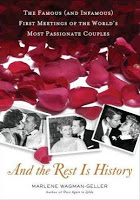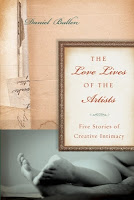If you are in the mood for a little short attention span biography mixed with a little (or a lot) of romance then And the Rest is History: the famous (and infamous) first meetings of the world’s most passionate couples (M) by Marlene Wagman Geller might be a good choice for your next read.
 Geller has selected thirty four couples from throughout history ranging from biblical Jacob and Rachel to contemporary Celine and Rene. Her couples weren’t necessarily chosen for the longevity (Heloise and Abelard were together long enough to produce a child, but were never to meet again) or fidelity (Richard Burton and Elizabeth Taylor, need I say more?). The relationship in question was not necessarily the one that resulted in marriage, but it is the one that had the most significant impact on both their lives. Geller tells the story of Aristotle Onassis’ and Maria Callas’ love affair which began while she was married to another. Although Onassis was distracted by and then married Jacqueline Kennedy, Geller writes that he maintained his relationship with Callas until his death. There is some sweetness – I have to admit the part about George Burns and Gracie Allen made me sniffle, and some awkwardness – Prince Charles and Camilla Shanda
Geller has selected thirty four couples from throughout history ranging from biblical Jacob and Rachel to contemporary Celine and Rene. Her couples weren’t necessarily chosen for the longevity (Heloise and Abelard were together long enough to produce a child, but were never to meet again) or fidelity (Richard Burton and Elizabeth Taylor, need I say more?). The relationship in question was not necessarily the one that resulted in marriage, but it is the one that had the most significant impact on both their lives. Geller tells the story of Aristotle Onassis’ and Maria Callas’ love affair which began while she was married to another. Although Onassis was distracted by and then married Jacqueline Kennedy, Geller writes that he maintained his relationship with Callas until his death. There is some sweetness – I have to admit the part about George Burns and Gracie Allen made me sniffle, and some awkwardness – Prince Charles and Camilla Shanda
And continuing in the romantic vein is The Love Lives of the Artists: five stories of creative intimacy (M) by Daniel Bullen.
 “Of the many freedoms we enjoy in modern society, none is more intoxicating or socially disruptive than the possibility that there might be alternatives to traditional marriage, and no one has shown us how to use this freedom better than the celebrities and artists whose unconventional relationships were evidence of creativity and individuality. But what do their stories tell us? What does the work of art do for an artist as a lover? And how do an artists’ affairs both emerge from and influence their creativity? “The Love Lives of the Artists” tells the stories of artists who saw the open relationship as the fulfillment of their art. Certainly, some used their open relationships to torture themselves and others; but some were able to ‘put up with a good deal of contradictory nonsense,’ as Georgia O’Keeffe put it – suffering nervous breakdowns or drug and alcohol addictions, along with jealous torments – in order to preserve creative connections to what seemed ‘clear and bright and wonderful’ in their artist lovers. In this engrossing examination, Daniel Bullen sheds light on the love lives of Lou Andreas-Salome and Rainer Maria Rilke; Alfred Stieglitz and Georgia O’Keeffe; Jean-Paul Sartre and Simone de Beauvoir; Diego Rivera and Frida Kahlo, and Henry Miller and Anais Nin.” publisher
“Of the many freedoms we enjoy in modern society, none is more intoxicating or socially disruptive than the possibility that there might be alternatives to traditional marriage, and no one has shown us how to use this freedom better than the celebrities and artists whose unconventional relationships were evidence of creativity and individuality. But what do their stories tell us? What does the work of art do for an artist as a lover? And how do an artists’ affairs both emerge from and influence their creativity? “The Love Lives of the Artists” tells the stories of artists who saw the open relationship as the fulfillment of their art. Certainly, some used their open relationships to torture themselves and others; but some were able to ‘put up with a good deal of contradictory nonsense,’ as Georgia O’Keeffe put it – suffering nervous breakdowns or drug and alcohol addictions, along with jealous torments – in order to preserve creative connections to what seemed ‘clear and bright and wonderful’ in their artist lovers. In this engrossing examination, Daniel Bullen sheds light on the love lives of Lou Andreas-Salome and Rainer Maria Rilke; Alfred Stieglitz and Georgia O’Keeffe; Jean-Paul Sartre and Simone de Beauvoir; Diego Rivera and Frida Kahlo, and Henry Miller and Anais Nin.” publisher



